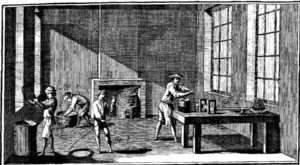
What a marvelous spectacle we have enjoyed this week, as the first wave of Covid-19 vaccines began shipping from Pfizer’s facilities in Michigan. Watching the news with my pre-teen son, as those box trucks rolled away carrying such precious frozen cargo, he said, “Wow, I bet that truck driver feels pretty good about his job right now.” I nodded and replied, “Well said, son. I think maybe this is something we can all feel good about.”
Who can’t feel good about the mind-blowingly short duration it’s taken to develop a safe and effective vaccine? For the same reason, we should also be amazed at the complexity of its distribution. The Wall Street Journal captures the point.
The effort to vaccinate the nation relies on chemists, factory workers, truck drivers, pilots, data scientists, bureaucrats, pharmacists and health-care workers. It requires ultracold freezers, dry ice, needles, masks and swabs converging simultaneously at thousands of locations across the country. To work, every one of the many and complicated links of the chain has to hold.
The distribution has been widely described as the biggest mobilization since World War II. Bravo!, I say. We need some awe-inspiring words to befit this marvelous spectacle.
And yet, the vaccine itself is a relatively simple compound. It consists of Pfizer’s modified mRNA plus seven inactive ingredients as common as table sugar. The mRNA itself stands as an unprecedented achievement. Yet the compound is ordinary, even elegantly so. And it will save millions. What beauty in the simple!
For many, this facet of the story evokes the classic essay with the curious title, “I, Pencil: My Family Tree as Told to Leonard Reed”. Originally published in 1958, this essay skillfully describes the materials that comprise an ordinary pencil, and the far reaches of the world whence those materials source. It also artfully describes the innumerable people around the world whose daily work contributes crucially to putting ordinary items such as pencils on nearby stores’ shelves.
That’s exactly how the WSJ describes the Pfizer mobilization. The vaccine must arrive at the right time in the right condition at thousands of locations around the country. And the efforts of myriad numbers of people from faraway places contribute to the mobilization. When you start to think about it, the amount of human coordination being achieved is astounding. It makes my son and me want to ask: Who designed such a marvelous plan? Who deserves credit for taking charge of this? The surprising answer that comes to us from the pencil is: no one! Leonard Reed’s ordinary little friend conveys the idea himself.
I, Pencil, am a complex combination of miracles: a tree, zinc, copper, graphite, and so on. But to these miracles which manifest themselves in Nature an even more extraordinary miracle has been added: the configuration of creative human energies—millions of tiny know-hows configurating naturally and spontaneously in response to human necessity and desire and in the absence of any human master-minding!
And again, the WSJ informs us exactly how this applies to how this week’s vaccine mobilization.
‘Everything has to come together—the packaging, the dry ice, the vials, the material itself. It all has to come together to the same place and have enough of it and exactly the right people there ready to take it,’ said Yossi Sheffi, director of the MIT Center for Transportation & Logistics. ‘Right now, there’s no conductor to the symphony,’ just many parts that each need to work.
This reflects the time-tested idea in economics that great things for humanity can be the result of people self-organizing through markets because they’re free to do so. Reed is channeling economics Nobel Laureate F. A. Hayek, whose 1945 article, “The Use of Knowledge in Society” describes market prices as a mechanism of human coordination that deserves to be marveled at.
I have deliberately used the word “marvel” to shock the reader out of the complacency with which we often take the working of this mechanism for granted. I am convinced that if it were the result of deliberate human design, and if the people guided by the price changes understood that their decisions have significance far beyond their immediate aim, this mechanism would have been acclaimed as one of the greatest triumphs of the human mind. Its misfortune is the double one that it is not the product of human design and that the people guided by it usually do not know why they are made to do what they do. But those who clamor for “conscious direction”—and who cannot believe that anything which has evolved without design (and even without our understanding it) should solve problems which we should not be able to solve consciously—should remember this: The problem is precisely how to extend the span of our utilization of resources beyond the span of the control of any one mind; and therefore, how to dispense with the need of conscious control, and how to provide inducements which will make the individuals do the desirable things without anyone having to tell them what to do.
Hayek is in turn channeling Adam Smith who pioneered the idea that people’s liberty to specialize and trade explains much of the wealth of nations. When people are free to truck, barter, and exchange according to their own terms, markets tend to happen, and price coordination tends to follow. For Smith, an invisible hand channels individual self-interest toward these broader gains. Toward a better life.
This old idea is discussed in today’s economics textbooks with section headings like “comparative advantage” or “gains from trade,” and in some books as “price coordination”. Critics count the idea as dogma, but most economists take it as one of the cornerstones of our trade. This is why, for example, most economists oppose tariffs.
If that doesn’t impress you, try this other facet. Consider that each recipient of the vaccine has effectively harnessed the myriad efforts of the scattered multitudes. Imagine it is your turn next. Now imagine for a moment what it would feel like to employ millions of workers around the globe and to funnel all their efforts directly toward you in the form of a single and concentrated dose of betterment to your own well-being. See, that didn’t hurt at all. Congratulations, you’ve just received your Covid-19 inoculation, thanks in part to the invisible hand.
My pre-teen son has a long life ahead of him, I hope. How much better will it be than mine? If you ask our ordinary little friend the pencil, the recipe for human flourishing is pretty simple. Just add one part specialization according to comparative advantage, add a bit of faith in free people, and let the good stuff rise as people better themselves through price coordination. Economic freedom is amazingly complex, and so is the vaccine marvel. Yet they both are beautifully simple, too. That’s something we can all feel good about.
—
Don’t get me wrong. Central planning is a major player in the success story we’re watching unfold. Vaccines are classically known to have inefficiencies on both the production and consumption sides, and non-price rationing is determining their allocation. It’s not like Pfizer is harnessing price-induced information to decide where shipments go. But still, there is pretty intense competition among vaccine suppliers. And there is something we can all feel good about here. Maybe even marvel at here. And much of it owes itself to the social coordinating force of market prices and globalized trade.

Edward J. Lopez teaches economics at Western Carolina University, where he is also director of the Center for the Study of Free Enterprise. His research focuses on the dynamics of legal and political institutions. His recent publications include “Informal Norms Trump Formal Constraints: The Evolution of Fiscal Policy Institutions in the United States” (Journal of Institutional Economics, 2017, with Peter T. Calcagno), and Madmen, Intellectuals, and Academic Scribblers: The Economic Engine of Political Change (Stanford University Press, 2013, with Wayne A. Leighton). He is Executive Director and Past President (2012-2014) of the Public Choice Society.

READER COMMENTS
Mark Brady
Dec 22 2020 at 5:49pm
Ed writes, “Don’t get me wrong. Central planning is a major player in the success story we’re watching unfold. Vaccines are classically known to have inefficiencies on both the production and consumption sides, and non-price rationing is determining their allocation. It’s not like Pfizer is harnessing price-induced information to decide where shipments go.”
So is this a defense of the mixed economy? 🙂
Mark Brophy
Dec 22 2020 at 10:58pm
We don’t know whether the vaccines are safe and effective but we’ll know in two years. In the meantime, take zinc glycinate and vitamins C and D, and if you’re carrying too much weight, lose some.
JdL
Dec 23 2020 at 6:58am
I wish I had the author’s blind certainty in the efficacy and long-term safety of the new vaccines. Both of these have yet to be demonstrated.
On second thought, I’m glad I’m skeptical. I’m over 70 but won’t take the vaccine for a year at least, and, since the virus will probably be mostly done spreading by then, probably never. The author is welcome to shoot himself up; I’ll pass.
Lydia
Dec 23 2020 at 5:52pm
Interesting article the good parts highlight, a la I Pencil, the coordination efficiency of markets, in this case with respect to distribution. Yes, that is truly amazing. But I think it is wrong to extend the attributes of market distribution efficiency to vaccine development which is a highly regulated, highly funded, highly integrated with risk-absolving government. The vaccine development demonstrates what is not seen, such as, treatments using compounds that are cannot be patented. HCQ comes to mind as a treatment not a vaccine. Also consider another widely used drug – Invermectin that treats the problem. If treatment is readily available is it cheaper and more efficient than producing a vaccine that may need three doses? The pharmacological industry has garnered political power, that insulates it from market direction.
Mark Bahner
Dec 24 2020 at 12:46am
Unfortunately, in terms of lives needlessly lot, the development time probably could have been a lot shorter.
Comments are closed.